Yellow Cymbidium Orchid is an orchid. It grows wild in the subtropics. Home hybrid varieties, of which there are at least a hundred today, are used to create decorative compositions.
The Yellow Cymbidium Orchid is capricious, growing it at home and achieving annual flowering is not easy, so beginners should choose the most unpretentious of the existing varieties, and devote maximum time to caring for the orchid.
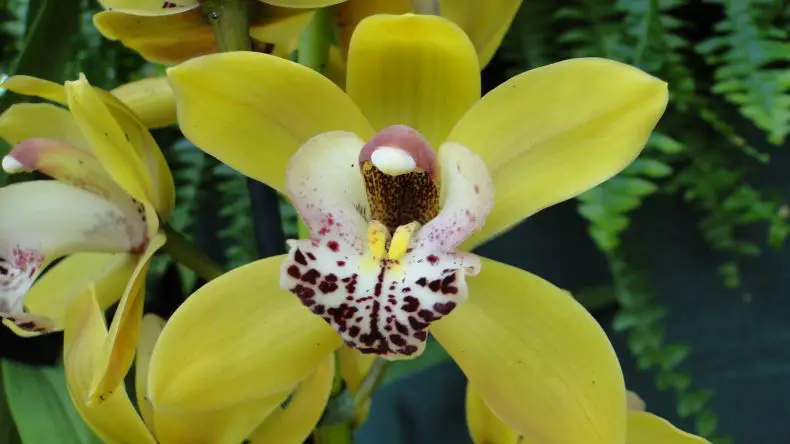
Popular varieties of Yellow Cymbidium Orchid
Despite the significant variety of cymbidium species with yellow color, no more than a dozen hybrids are favorites among gardeners. When choosing a plant, they are guided mainly by its ability to develop in specific conditions, as well as by its appearance.
Cymbidium aloifolium
In the wild, the cymbidium stem reaches 1.5 meters. The hybrid variety of the aloe cymbidium rises no more than 0.3 meters above the ground, so the aloe leaf orchid is classified as a dwarf orchid.
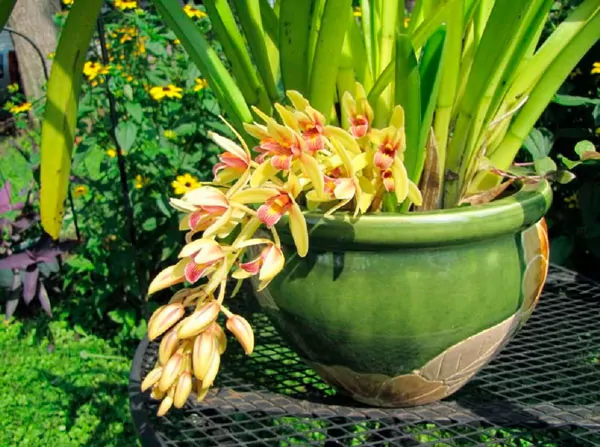
The color of the buds is burgundy or cream with a slight yellowness. The buds open by 4-4.5 cm. This happens in the spring.
Tracy’s Cymbidium (cymbidium tracyanum)
The most beautiful variety of multi-flowered orchids. The flowers are large up to 15 cm with light green buds. Many brown lines run along the veins of the petals.
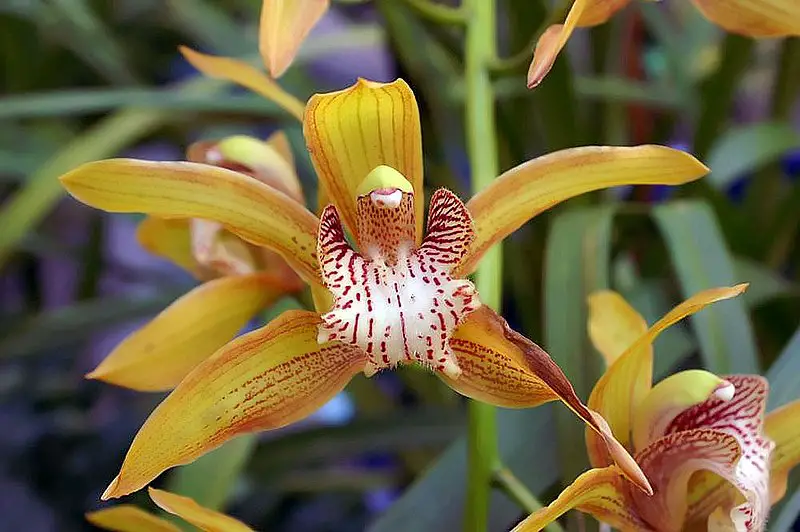
The front of the cream lip is also mottled. Its edges are wavy or fringed. Reaches a height of 1.2 m, in September at least 20 flowers appear on each brush.
Cymbidium lowianum
A large-flowered orchid with buds opening of 20 cm or more. The flowers are light green with an admixture of yellow. The lip has three dark crimson lobes, a bright yellow stripe runs along the edges of the middle lobe.
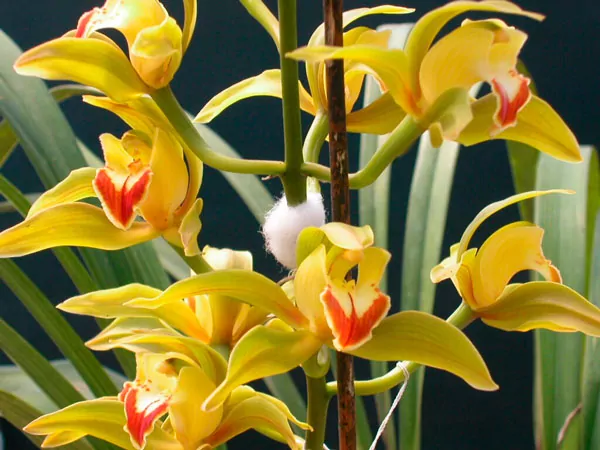
The stem reaches 1 m in height, the leaves are extended by 0.75 m. Lowe was brought from Burma, among flower growers the most popular hybrid variety “Liliput” grown on its basis is considered. Blooms in February.
Cymbidium mechelistny (Cymbidium ensifolium)
Undemanding plant. The stem is erect, from 15 to 65 cm long. On the peduncle there are up to 9 small buds, no more than 3-4 cm in diameter. The petals are pale yellow, each with burgundy veins.
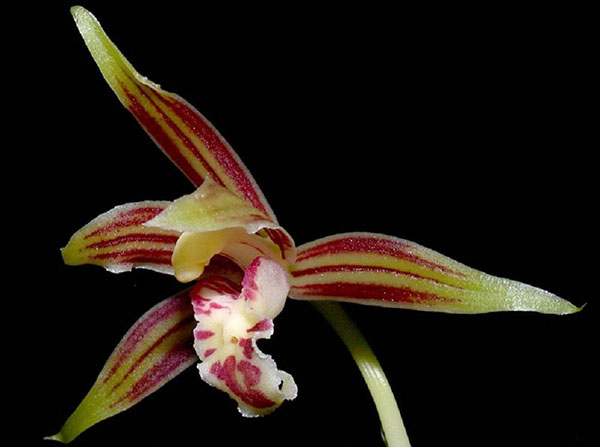
The lip is pale yellow or light green, there are dark coral in the middle part, and brown stripes on the sides. Based on the wild-growing species, such hybrid varieties have been created as: Peter Pan, Lovely Melody and Golden Elf. Blooms all winter and most of spring.
Giant cymbidium (cymbidium giganteum)
A small orchid with yellow-green buds covered with brown stripes. The lip is creamy, spotted and striped. The diameter of the buds is 12 cm, the length of the inflorescence is 0.6 m.
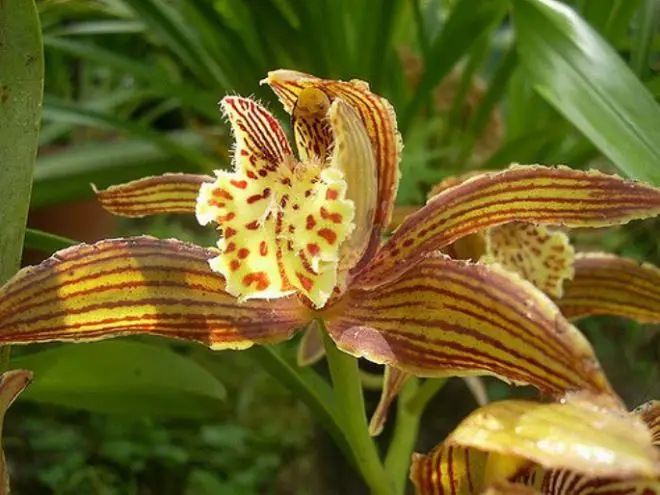
It grows in the Himalayas, blooms in November, and fades in April. Flowers do not dry out for a long time, remaining fragrant and alive for 3-4 weeks.
Here we have Cymbidium Pseudobulbs Varieties details and descriptions.
Yellow Cymbidium Orchid Care at home
Cymbidium is a plant that needs care and cares all year round. An adult orchid grows by 1.5 meters and actively blooms with proper care.
Particular attention is paid to such parameters as lighting, soil and air moisture levels, temperature, top dressing.
Lighting
Cymbidium loves light, so well-lit window sills are chosen when placing it in a room.
In winter, the plant is artificially illuminated, and in summer it is shaded a little, protecting it from the sun.
Attention! Lack of light leads to lack of flowering.
Yellow Cymbidium Orchid Watering and humidity
In summer watered 2-3 times a week, in winter 1-2 times a month. Sprayed three times a day. Water is heated or settled. Expanded clay and pebbles help to increase humidity.
Temperature
It grows well at an air temperature of 18-20 degrees Celsius and above. In summer, the plant should be shaded, removed from the southern window sills, and kept away from radiators and fireplaces in winter.
Soil
For transplantation use a special substrate. The soil should be loose, soft and well fertilized.
Top dressing and fertilizer for Yellow Cymbidium Orchid
The orchid needs constant feeding, at least 1 time per week. At the same time, the amount of fertilizer indicated by the manufacturer as a norm is reduced by 2 times.
So, if for 1 liter of water, according to the instructions, it is proposed to take 1 cap of liquid fertilizer, then it is better to use 0.5 of this amount. In summer, the proportion of potash fertilizers is increased, in autumn and winter nitrogenous.
Attention! Blooming orchids do not feed.
For growth, any top dressing containing potassium and nitrogen is suitable, but it is better to use specialized mixtures designed specifically for use on orchids.
Illumination in the autumn-winter period
With a decrease in the amount of natural light, the orchid is illuminated. To do this, use LED lamps and fixtures.
You can understand that the plant does not receive enough light by lowered leaves and drying buds.
During flowering
When flowering, they try not to disturb the orchid, they do not transplant it and do not feed it, but water it and often spray it. Shriveled buds are carefully removed from the stem, providing more space for those that have not yet faded.
After flowering
After all the flowers have dried, the orchid is transplanted into a new pot, if necessary, fertilized. If flowering ends in winter, then neither the first nor the second need to be done, it is enough to remove the pot from a well-lit window sill, for example, to the east or north window, and let the orchid rest.
Actively watering and fertilizing the soil begins in March. Be sure to cut off the peduncle after flowering, leaving no more than 2.5 cm above the base.
Attention! Pruning is carried out with secateurs or scissors, but you can simply break off the stem that is no longer needed. In the latter case, the risk of infection is reduced, due to which most orchids get sick and die.
flowering period of Yellow Cymbidium Orchid
Each variety of cymbidium blooms at the time allotted for it. So, if you grow several types of this orchid on one windowsill, then you can achieve that they will delight with flowers all year round.
For example, aloe cymbidium blooms in April or May and blooms until September-October, when Tracy blooms. Without beautiful fragrant flowers, a cymbidium lover will definitely not be left.
How to make Yellow Cymbidium Orchid bloom
A faded orchid begins a dormant period. If we are talking about the Aloe leaf type of cymbidium, then this is September-January. In January, the plant wakes up and begins to grow actively – young leaves appear, the appearance of the orchid improves.
At this time, she needs additional lighting, watering and top dressing. Around the beginning of April, the orchid should bloom. If this does not happen, then you should start looking for the problem that provoked such a state of the flower. For testing, you can:
- take the orchid to the balcony, perhaps it does not have enough light or heat;
- remove additional lighting (an excess of light is also the reason for the lack of buds);
- lower the air temperature at night to 14-16 degrees Celsius;
- reduce or, conversely, increase watering.
In the store, you need to buy special fertilizers. Topdressing will improve the plant’s well-being and provoke it to active development and flowering.
This video talks about the basic conditions for flowering cymbidium:
Yellow Cymbidium Orchid Propagation and reproduction
Cymbidiums are propagated by dividing the mother bush or growing a new one from seeds. The last option is the most time-consuming and expensive.
Yellow Cymbidium Orchid propagating by division of bush
Only strong, healthy bushes are subjected to division. An adult bush is divided into several separate bushes with a sharp knife. On each new bush, 3-4 pseudobulbs remain (thickening in the stem). The shoots are placed in the soil for adult orchids and sprinkled with earth.
Yellow Cymbidium Orchid propagating with seed
For planting seeds you need:
- the seeds themselves;
- glass containers with lids;
- substrate;
- cotton wool.
The containers and the substrate are sterilized (you can pour boiling water over the jars, and lower the substrate into a pressure cooker for 15-20 minutes). Seeds are soaked for about 10 minutes in a bleach solution. The substrate is poured into jars, sterilized seeds are planted, and closed with a lid.
In the lid, you need to make 2-3 holes, plugging them with a cotton swab. After a week, the seeds will germinate and the first leaves will appear on the surface. Through the holes in the lid, they can be lightly sprinkled with boiled, and cooled to room temperature water.
It is impossible to use ordinary soil for planting seeds. They just rot. The best option is a mixture of live moss, fern roots, and pine bark.
Yellow Cymbidium Orchid Landing and transplant
Orchids are prone to various infectious diseases, so the pot, spatula, and even gloves are wiped with disinfectants. The soil can be spilled with a solution of potassium permanganate and boiling water.
An adult plant is transplanted 1 time in 2-3 years. Transplantation is carried out when the roots of the plant begin to bulge out of the pot. You need to take a larger pot and transfer the orchid into it. Before transshipment, damaged roots are removed.
The plant planted in a new container is covered with earth, trying to cover all the roots, and then rammed. The cymbidium should sit tightly in the pot, do not be afraid to pull the stem along with the leaves immediately after transplanting. If the bush easily comes out of the ground, you need to tamp it down properly again.
After transplantation, the plant is carefully watered, trying not to flood, and placed in a dark place for about 1 week.
Attention! Immediately after the purchase, there is no need to transplant the cymbidium.
However, if the plant has been overwatered, it is best to report as shown here:
soil for Yellow Cymbidium Orchid
If there is no soil in the store, then it is prepared independently from:
- pine bark;
- sphagnum moss;
- sand;
- perlite;
- charcoal.
Carefully! If the mixture is selected independently, then when collecting the bark, you need to carefully examine it for the presence of bugs and signs of illness, and then douse it with boiling water several times. The same procedure should be repeated for other soil components.
When is it time to transplant
If the earth ceases to shine through the transparent pot, and only the roots remain in the field of view, it is time to transplant the orchid.
Additionally, you can take a simple pencil and try to stick it into the soil, if this fails, then a cymbidium transplant is definitely necessary.
This video details how to transplant an orchid after flowering:
Yellow Cymbidium Orchid Diseases
Cymbidium often gets sick, its roots rot, leaves fall off, and there is no flowering due to damage to the plant by viruses, bacteria, and parasitic insects.
Cymbidium Orchid Root rot
Orchid roots begin to rot when overflowing. It is also a sign of their defeat by black rot. The cause of the development of the disease is excessive humidity and low temperature. A plant experiencing similar problems needs:
- pull out of the pot;
- get rid of the earthy coma, completely clean the roots from the earth;
- remove damaged parts;
- disinfect the new pot and the ground;
- pour over the roots with a weak solution of potassium permanganate;
- make a transplant.
Watering is reduced to 1 time per week in summer and 1 time per month in winter. In winter, transplantation is carried out only as a last resort.
Viral mosaic
The main symptom of the disease is elongated dark green and brown spots on the leaves. A diseased plant withers, its growth slows down. If a sprout is affected, then it can no longer grow into a full-fledged orchid. For treatment, special mixtures are used. The affected orchid is separated from healthy ones.
leaf swelling
The leaves swell due to the overflow of the plant or the presence of orchid roots in water for a long period of time. To prevent this, immediately after watering, all excess water is drained from the pan.
Pests
Yellow Cymbidium Orchid affects:
- spider mite;
- flies;
- scab;
- thrips;
- root flour mite;
- aphid;
- centipede;
- legtail;
- snail.
Attention! Recognizing the signs of the disease is not easy at once. Changing the shade of the leaves and the quality of the substrate all is what they pay attention to. Perhaps ticks, thrips, or centipedes are operating in a pot.
Yellow Cymbidium Orchid Growing problems
Orchids often get sick and therefore die, it is almost impossible to grow a new plant from seeds, and when propagated by bulbs, there is a risk of infection with harmful bacteria not only for children but also for an adult plant. How to avoid it? Let’s talk in more detail.
Black spots at base of Yellow Cymbidium Orchid leaves
If the leaves turn black at the base, then this is a clear sign of black rot. It also causes root rot. The only way out is to urgently transplant and temporarily stop watering.
Yellowing and deformation of Cymbidium Orchid leaves
Orchid leaves often turn yellow and deform. This situation may be evidence of sunburn, the development of bacterial plant spots, or chlorosis. With a sunburn, it is enough to move the pot to the shade.
Bacterial spotting appears as the first yellow, and then brown spots, leading to leaf deformation.
The only way to get rid of it is to use fungicides and remove damaged parts of the plant.
Chlorosis develops with a lack of iron, the cause of it is watering with hard water from the tap. To improve the appearance of the plant, distilled or rainwater is subsequently used, and the plant is transplanted into acidic soil. To increase the amount of iron, increase the number of top dressings.
When the leaves are deformed, the plant is inspected for pests. Perhaps the damage is due to the presence of aphids, mites, or scale insects.
Resetting buds and flowers
If an orchid sheds buds and flowers but retains a beautiful appearance, then the cause is sought in improper care. Possible reasons are:
- low temperatures;
- direct sunlight;
- lack of the required amount of light.
A sharp change in the location of the flower pot can also lead to a drop in flowers, so it is better not to disturb the orchid during flowering.
Shrinkage of the pseudobulb
If the pseudobulb shrinks and rots, then you need to reduce watering, the affected areas of the plant are removed.
root rot
Roots rot due to moisture and pests. So, the root mite affects their condition. It appears at low temperatures and high humidity. The tick is easy to recognize in the soil – it has a white, almost transparent body. Fungicide treatment helps to get rid of the pest.
Attention! Roots damaged by water or pests are removed. In order to prevent this from happening in the future, it is better to draw up a watering schedule at different times of the year and follow it exclusively.
Cymbidium is a beautiful orchid, numerous species and varieties are very popular with flower growers. The orchid is a finicky plant, it is not easy to grow it at home.
Improper care, excessive watering, untimely transplantation, and plant exposure to direct sunlight, leads to death. Cymbidium is susceptible to fungal and viral diseases, it is often affected by pests.
